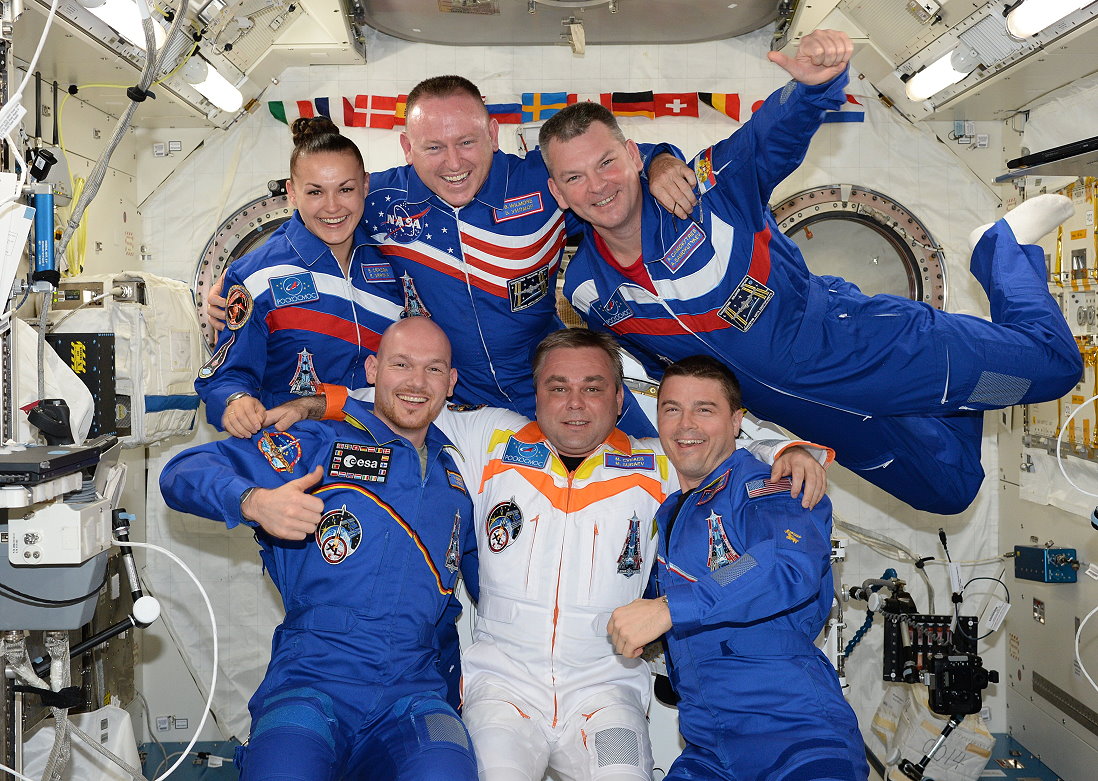
Expedition 42 is formally underway aboard the International Space Station (ISS), following the traditional change-of-command ceremony Saturday, 8 November, between outgoing skipper Max Surayev of Russia and his NASA replacement, Barry “Butch” Wilmore. Surayev and his crewmates Reid Wiseman of NASA and Germany’s Alexander Gerst of the European Space Agency (ESA) will board their Soyuz TMA-13M spacecraft later this evening (Sunday, 9 November) and return to Earth, concluding 165 days in orbit. They will leave Wilmore and his crew of Russian cosmonauts Aleksandr Samokutyayev and Yelena Serova—who have been in space since 25 September—as a three-member team for two weeks, ahead of the planned 24 November launch of Soyuz TMA-15M, which will restore the ISS to its nominal, six-person strength.
Current plans envisage Surayev, Wiseman, and Gerst to bid their comrades goodbye and close the hatches between the station’s Earth-facing (or “nadir”) Rassvet module and their Soyuz TMA-13M spacecraft at about 3:45 p.m. EST Sunday. Undocking is expected to occur at 7:30 p.m., kicking off a 3.5-hour return to the desolate steppe of Kazakhstan, near the remote town of Dzhezkazgan. During that period of free flight, they will execute the 4.5-minute deorbit “burn” of the Soyuz spacecraft’s engines at about 10:05 p.m., after which they will jettison their spherical orbital module and cylindrical instrument module at about 10:30 p.m. With the three men ensconced inside the beehive-shaped descent module, they will then be primed to begin the perilous hypersonic descent back through the “sensible” atmosphere. “Entry Interface,” at an approximate altitude of 400,000 feet (122 km), should be reached at about 10:34 p.m., after which friction with the steadily thickening atmosphere will rapidly heat the spacecraft’s outer surfaces.
Eight minutes later, Soyuz TMA-13M will come streaking, meteor-like, through the night sky at a velocity in excess of 515 mph (830 km/h), heading for its touchdown point in central Kazakhstan. However, it will be slowed rapidly, thanks chiefly to the deployment of four parachutes, beginning about 15 minutes before it hits the ground. Two “pilot” chutes will be released, followed by a 258-square-foot (24-square-meter) drogue, which will arrest Soyuz TMA-13M’s rate of descent to about 180 mph (290 km/h). Finally, the main canopy—with a fully deployed surface area of 10,764 square feet (1,000 square meters)—will be deployed, shifting the spacecraft’s attitude to a 30-degree angle, relative to the ground, steadily dissipating heat, then shifting it back to a straight-vertical descent profile for landing. The main canopy will slow the Soyuz to a stately 16.4 mph (26.4 km/h), still too fast for a safe landing. The turn will then come for the solid-fueled rockets in the descent module’s base, which will fire in the last two seconds to cushion the touchdown.
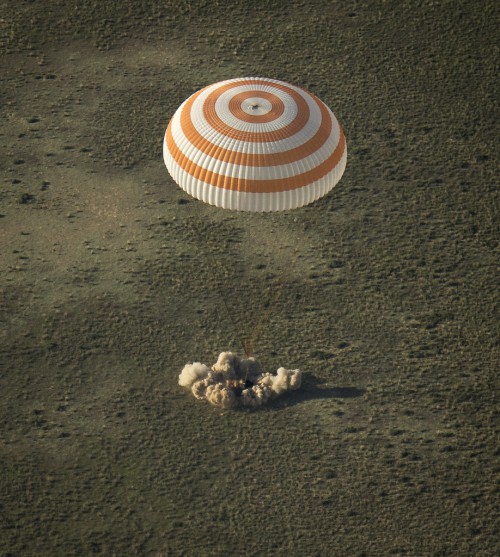
Assuming all goes well, Surayev, Wiseman, and Gerst should hit terra firma at 10:58 p.m. EST Sunday (9:58 a.m. local time Monday), concluding an ambitious mission of 165 days, eight hours, and one minute, as well as about 2,580 orbits of the Home Planet. This will end the first career spaceflight for both Wiseman and Gerst, who also completed their first spacewalks during Expedition 41, and the second mission of Surayev, who previously served for 169 days during Expedition 22 between September 2009 and March 2010. His cumulative space-time tally will thus increase to 334 days, 12 hours, and 11 minutes, placing him in 38th place on the list of the most experienced spacefarers of all time, behind Talgat Musabayev and slightly ahead of Roman Romanenko.
Aside from the long duration of their flight, the journey of Surayev, Wiseman, and Gerst has been ambitious and full of drama. The excitement from the “rookie” crew members was apparent in their messages, tweeted before and during the journey to launch pad. Gerst told his 23,600 followers that “Adrenaline is rising, but feel relaxed,” whilst Wiseman signed off to his 21,300-strong Twitter crowd with “Time for me to focus on the task at hand. Next tweet will be from space! Cheers, Reid.” The three men were launched from Baikonur Cosmodrome in Kazakhstan at 1:57:41 a.m. local time on 29 May (3:57:41 p.m. EDT on 28 May), and—following a now-standard “fast rendezvous” profile—successfully docked at the nadir-facing Rassvet module of the ISS approximately six hours later. They were welcomed as the newest members of the incumbent Expedition 40 crew by Commander Steve Swanson of NASA and Russian cosmonauts Aleksandr Skvortsov and Oleg Artemyev, who had been aboard the orbital outpost since late March.
At the time of their arrival, in addition to their own Soyuz TMA-13M and the Soyuz TMA-12M spacecraft, belonging to Swanson, Skvortsov, and Artemyev, there were two unpiloted visiting vehicles in residence at the ISS. Progress M-23M had arrived in April, whilst Progress M-21M had been in orbit since November 2013, but had undertaken a brief undocked phase of a few days in late April to support tests of a new Kurs-NA (“Course”) rendezvous and navigation system. Progress M-21M separated from the space station for the final time on 9 June, carrying trash and unneeded equipment, and was intentionally destroyed during re-entry. Seven weeks later, on 21 July, Progress M-23M was itself undocked and deorbited to make room for Progress M-24, whose rose into space on 23 July. The latter undocked just two weeks ago, on 27 October, for several weeks of independent scientific experiments, after which it will be deorbited on 20 November. Most recently, Progress M-25M was launched from Baikonur on 29 October and successfully docked at the station’s Pirs module about six hours later. Current projections call for it to remain in place until late April 2015. Each of these Progress resupply ships arrived laden with around 6,000 pounds (2,700 kg) of food, fuel, equipment, and supplies for the crew.
In the meantime, Orbital Sciences Corp.—one of NASA’s two Commercial Resupply Services (CRS) partners—successfully launched its second dedicated Cygnus spacecraft (ORB-2) towards the ISS on 13 July, atop an Antares booster from Pad 0A at the Mid-Atlantic Regional Spaceport (MARS) on Wallops Island, Va. Three days later, Cygnus arrived in the vicinity of the space station and was grappled by the 57.7-foot-long (17.6-meter) Canadarm2 robotic arm and berthed at the nadir port of the Harmony node. With Steve Swanson at the Canadarm2 controls, Alexander Gerst established video, power, and data utilities between Japan’s Kibo laboratory and the multi-windowed cupola, in order to support the Hardware Control Panel (HCP) to communicate with Cygnus. Early on the morning of 16 July, Wiseman tweeted a remarkable image of the cargo ship’s brilliantly lit solar arrays, barely visible against the cobalt-blue oceans of Earth. Aboard Cygnus was almost 3,300 pounds (1,500 kg) of cargo. The spacecraft remained in place until mid-August, whereupon it was unberthed and deorbited over the Pacific Ocean.
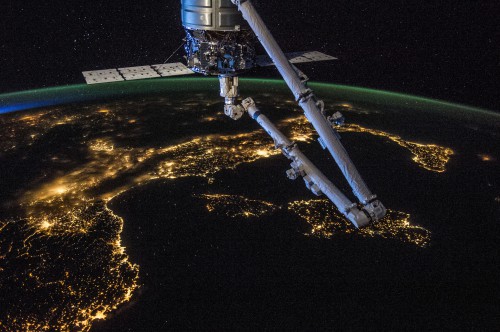
It was already turning into a hot and heavy summer of resupply for the ISS, with the European Space Agency (ESA) launching its fifth and final Automated Transfer Vehicle (ATV-5), atop an Ariane 5 booster from the Guiana Space Centre in Kourou, French Guiana, on 29 July. Laden with 14,300 pounds (6,500 kg) of payloads, the ATV followed an automated, two-week rendezvous profile, docking at the aft longitudinal port of the space station’s Zvezda service module on 12 August. The approach and docking was closely monitored by Aleksandr Skvortsov and Alexander Gerst, who opened the hatches early on the 13th and began an inspection of the spacecraft’s interior. They found nothing amiss and began the lengthy process of unloading ATV-5’s cargo. The European supply ship—which is the last of its kind, although its design legacy will endure as it provides the foundation for the Service Module (SM) of Orion’s Exploration Mission (EM)-1 in 2018—will remain attached to the ISS until late January 2015, when it will be deorbited.
By the beginning of September, Expedition 40, under Swanson’s command, drew inexorably toward its close. Aside from the traffic of visiting vehicles, it had been an exciting period aboard the ISS, with ongoing research into human behavior and performance, studies of animal biology and bone and muscular physiology, as well as technology demonstrations, investigations into the physical and space sciences, and numerous educational activities having taken place. In terms of public outreach, the crew had proven particularly enthusiastic, with daily images of Earth and life in space tweeted back to their ground-based followers. With U.S. and German crew members, they had watched the World Cup match between the two nations and, later, had witnessed Germany’s triumphant victory over Argentina on 13 July. At one stage, the crew was even serenaded from Mission Control with a chorus of “I Won’t Give Up” by singer-songwriter Jason Mraz.
Late on 9 September, in a televised address, Swanson formally handed command of the ISS to Max Surayev, officially ending Expedition 40 and heralding the start of Expedition 41. Next day, Soyuz TMA-12M brought Swanson, Skvortsov and Artemyev safely back to Earth, after 5.5 months in orbit, leaving Surayev, Wiseman, and Gerst as a three-member crew for the next two weeks. This is typical operating protocol for the ISS, which usually follows an “indirect” handover of its six-strong crew, whereby a three-person subset departs, reducing the station’s population to three, after which it is restored to six by the subsequent arrival of another three-member team. The second “half” of Expedition 41 was launched from Baikonur on 25 September, with cosmonauts Aleksandr Samokutyayev and Yelena Serova—the latter of whom became only the fourth Russian female space traveler in history—joined by NASA’s Barry “Butch” Wilmore. Six hours after leaving Earth, the new crew docked at the ISS and Expedition 41 was brought up to full, six-person capacity.
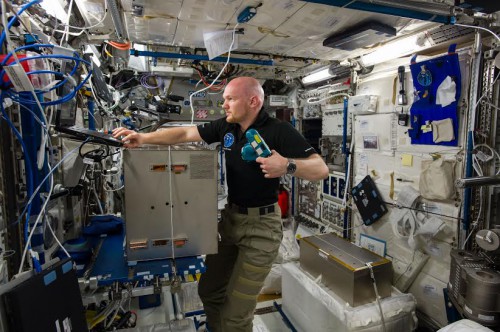
However, Surayev, Wiseman, and Gerst’s brief spell as a three-strong crew had been far from uneventful. On 21 September, SpaceX launched its fourth dedicated Dragon cargo mission (SpX-4) from Space Launch Complex (SLC)-40 at Cape Canaveral Air Force Station, Fla., atop a Falcon 9 v1.1 booster. As NASA’s second CRS partner, SpaceX—like Orbital Sciences—is tasked with providing a series of cargo missions by 2016. Under the language of their respective contracts, both companies are required to deliver a total of 44,000 pounds (20,000 kg) of equipment and supplies to the ISS. In a manner not dissimilar to Cygnus, the Dragon was captured by means of Canadarm2 on 23 September and robotically berthed at the nadir port of the Harmony node.
Expedition 40 and 41 had already featured two Russian spacewalks, on 19 June and 18 August, both conducted by Aleksandr Skvortsov and Oleg Artemyev. These involved the installation of an Automated Phased Antenna Array (AFAR) as part of the Russian segment’s command and telemetry system, together with the relocation of external experiments, the gathering of samples, the deployment of a Peruvian nanosatellite, and photography of the condition of multi-layered insulation. The first of these EVAs lasted for seven hours and 23 minutes, making it the fourth longest Russian spacewalk in history. It fell shy of last December’s eight-hour-seven-minute EVA by Expedition 38’s Oleg Kotov and Sergei Ryazansky, the seven-hour-41-minute spacewalk by Expedition 15 crewmen Fyodor Yurchikhin and Clay Anderson in July 2007, and the seven-hour-29-minute excursion by Yurchikhin and Aleksandr Misurkin in August 2013.
Two U.S. EVAs were originally planned for the July-August 2014 timeframe, performed by Swanson-Wiseman and Wiseman-Gerst, to transfer a failed ammonia pump module to a long-term storage location and replace a failed Sequential Shunt Unit (SSU) on the station’s starboard truss. These spacewalks were postponed when it became clear that issues had arisen with the Long Life Batteries (LLBs) aboard the U.S. Extravehicular Mobility Unit (EMU) space suits. Four replacement batteries were therefore carried into orbit aboard the SpX-4 Dragon and aboard Soyuz TMA-14M, enabling NASA to confidently reschedule the two EVAs for the first half of October. With Swanson now gone, the spacewalking line-up was adjusted, with Wiseman-Gerst performing the first EVA on 7 October and Wiseman-Wilmore performing the second on 15 October. None of the trio had performed a spacewalk before, although all had trained extensively for their tasks in the Neutral Buoyancy Laboratory (NBL) at the Johnson Space Center (JSC) in Houston, Texas.
Interestingly, this was also the first career space mission for both Wiseman and Gerst. This meant that, for the first time in more than two decades—not since the EVA of Carl Walz and Jim Newman during STS-51 in September 1993—a pair of first-time spacefarers embarked together on their first career EVAs, wearing U.S.-built EMUs. During their six hours and 13 minutes outside the ISS, Wiseman and Gerst successfully moved the failed pump module to its long-term storage location, replaced a failed camera light, and installed a new Relay Assembly to provide power redundancy for the railroad-like Mobile Transporter (MT), along which Canadarm2 traverses to reach its various work sites. Wearing the red, black and gold national tricolor on the arm of his space suit, Gerst became only the third German citizen, after Thomas Reiter and Hans Schlegel, to participate in an EVA.
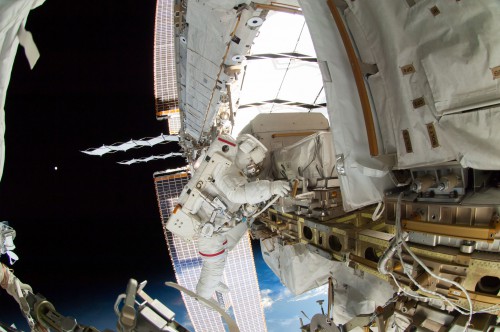
Eight days later, on 15 October, Wiseman and Wilmore ventured outside for six hours and 34 minutes to replace the starboard SSU—which malfunctioned and was declared failed back in May 2014—and to remove and relocate cameras and equipment in anticipation of next year’s arrival of two International Docking Adapters (IDAs) and the movement of the Leonardo Permanent Multipurpose Module (PMM) for future Commercial Crew vehicles. Wilmore became the first former shuttle pilot to participate in an EVA in more than a decade, since Ken Bowersox in April 2003.
Rounding out Expedition 41’s rapid-fire series of spacewalks, Max Surayev and Aleksandr Samokutyayev ventured outside the ISS in Russian suits on 22 October. The duo, both making their second career EVAs, breezed through six hours’ worth of activities in just three hours and 38 minutes. They removed and discarded an experiment package and a pair of unneeded rendezvous antennas, gathered samples from the exterior of the Russian segment of the station, and performed a comprehensive photo-documentation task. No further EVAs are anticipated from the station before year’s end, and Surayev and Samokutyayev’s excursion brought the running tally to three U.S. and four Russian spacewalks in 2014.
With the completion of their EVAs, Surayev now has two spacewalks under his belt: one from Expedition 41 with Samokutyayev and a previous excursion which he undertook with Russian cosmonaut Oleg Kotov during Expedition 22, back in January 2010. He has now accrued a total of nine hours and 22 minutes of spacewalking time, which places him in 150th place on the list of 211 men and women who have ventured outside their spacecraft in pressurized suits since Alexei Leonov in March 1965. Wiseman, who has totaled 12 hours and 47 minutes in his two EVAs, is slightly higher on the list in 120th place, whilst Gerst—with six hours and 13 minutes—ranks 172nd.
As their expedition headed into its final days, Surayev, Wiseman, and Gerst showed no signs of slowing down the pace of scientific research and maintenance which has characterized their 5.5 months in orbit. Only last week, as described by AmericaSpace’s Sherry Valare, Gerst busied himself with the installation of a high-speed camera, gas filter, gas purification cartridge, and sample chamber into the Electromagnetic Levitator (EML) in Europe’s Columbus laboratory. This furnace, which made its debut during Gerst’s “Blue Dot” mission, has the capacity to heat samples to 2,100 degrees Celsius (3,800 degrees Fahrenheit) and cool them rapidly. Elsewhere, Wiseman completed several high-density protein crystal growth investigations, the samples of which were safely returned to Earth on 25 October aboard the SpX-4 Dragon. The final days of Expedition 41 were sadly marred by the catastrophic failure of Orbital Sciences’ third dedicated Cygnus cargo mission (ORB-3), which was destroyed and 5,050 pounds (2,290 kg) of ISS-bound crew supplies, equipment, tools, and experiments lost in the explosion of its Antares booster on 28 October.
With the close of Expedition 41, the ISS will remain crewed by Wilmore, Samokutyayev, and Serova for the next two weeks, after which Soyuz TMA-15M will rocket into orbit from Baikonur on 24 November to bring the new Expedition 42 up to full, six-person strength, through the spring of 2015. Aboard the incoming spacecraft will be Russian cosmonaut Anton Shkaplerov, U.S. astronaut Terry Virts, and Italy’s first woman in space, Samantha Cristoforetti, one of whose most publicly visible “payloads” will be the first espresso coffee machine ever used in microgravity. This year’s Christmas and New Year period will also mark the first occasion in history on which as many as two women have been in orbit at the same time. A full report on the Expedition 41 crew’s return to Earth and a glance forward at the plans for Expedition 42 will appear tomorrow.
Want to keep up-to-date with all things space? Be sure to “Like” AmericaSpace on Facebook and follow us on Twitter: @AmericaSpace




Buy Plastic Trays